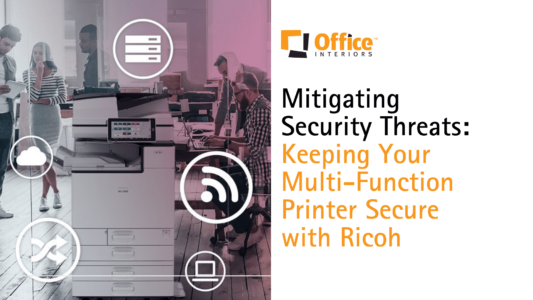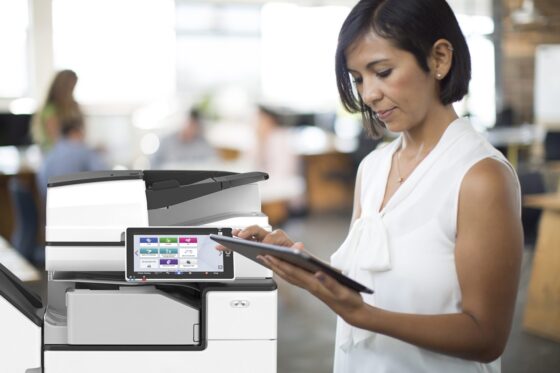With cyber threats on the rise, print security is an area that is often overlooked but has become an essential concern for businesses across the board. While printers were once perceived as low-maintenance and relatively safe devices, they have evolved into more than simple output devices that power business workflows and document management. These sophisticated pieces of technology are connected to your network and process a significant volume of your organization’s data.
Moreover, as work expands beyond the office, print solutions must adapt to home and remote working locations to ensure data protection across all printing tasks regardless of the setting. This article delves into the most common security threats linked to multi-function printers (MFPs) and best practices to keep your devices secure with Ricoh.
The Risk of Unsecured MFPs
Quocirca’s Global Print Security Landscape Report 2023 revealed that 61% of IT decision-makers experienced data losses from unsecured printers, 39% faced challenges in maintaining printer security, and only 19% were confident in their printer security’s ability to prevent data breaches.
Unprotected printers pose a substantial risk that goes beyond mere inconvenience. They heighten the potential for data breaches, hacking attempts, financial setbacks, and compliance breaches, presenting a lateral threat that can impact various dimensions of an organization’s network security.
What Are the Most Common Security Risks Associated with MFPs?
- WiFi-Related Challenges
Many office printers link to wireless networks, posing various security vulnerabilities. Threat actors can manipulate printers to connect to untrustworthy networks, enabling hackers to spread malware and print false or harmful documents through wireless printing.
- Hacked Print Jobs
Internal and external threat actors can disrupt operations by tampering with print jobs. Attackers can add, remove, or modify content from print jobs, kickstarting a domino effect of problems. Additionally, print logs are at risk of being manipulated, making audit trails challenging.
- Physical Access to Sensitive Documents
Without user authentication, anyone nearby can access and print private, sensitive, and high-value documents on a printer. This poses a substantial risk, causing anyone to potentially compromise or expose sensitive information, private data, and intellectual property.
- Data Theft from Decommissioned Printers
All network endpoints, including MPFs, must go through a comprehensive security lifecycle. This lifecycle begins with commissioning and configuring a printer and deleting all data before decommissioning and discarding it. Cybercriminals can steal high-value information from printers that have been decommissioned without data erasure.
- Overall Network Compromise
Unsecured printers have also been used as a backdoor into an otherwise protected network, allowing the hacker to breach the overall network, not just the print network/printer fleet.
What Are the Best Practices to Keep Your MFP Secure?
Many MFPs from manufacturers like Ricoh now incorporate enhanced security features. Coupled with sophisticated software and applications, they provide the flexibility and scalability required for a distributed workforce and assure data safety. Here are some safety measures you can take on your Ricoh devices:
- Always Encrypt Data
Your printers should have built-in data encryption capabilities to protect all incoming and outgoing data. Consider upgrading to devices with advanced technologies like Trusted Platform Module (TPM 2.0) for enhanced encryption and data protection, along with Solid-State Drive (SSD) storage that makes the recovery of deleted data more challenging. These features effectively reduce the risk of data leaks, adding an extra layer of security to your print operations.
- Implement User Authentication
User authentication is crucial for printer security. You can allow authorized individuals to access the device using swipe cards or pin authentication. Utilize traceable user IDs to monitor and hold users accountable for their printing activities, enhancing the overall security of your sensitive data.
- Keep Your Devices Up to Date
Older MFPs are an easy target for hackers. Ricoh’s Always Current Technology (ACT) allows for automatic software updates on MFPs, meaning that potential security issues are regularly patched and updated remotely and instantly, not allowing for long periods of downtime where hackers can find an opportunity to enter the device.
Additionally, when MFPs have downtime due to service issues, employees may create workarounds and use less secure methods of making copies and printers or use unsecured equipment. Ensure your MFPs offer remote insights and configuration, providing alerts on critical service issues to prevent downtime. Scheduled updates ensure minimal disruption during peak usage hours.
- Monitor Printing Patterns Regularly
Device management solutions offer centralized control and management, providing insights for understanding user behaviour, configuring machines, identifying risks, and ensuring smooth operation. It collects usage data for printing, copying, scanning, and faxing, offering organizations visibility into MFP usage.
Additionally, the solutions provide insight into critical security settings such as installed solutions, open ports, protocols, passwords, and hard drive presence. Administrators can establish security settings for each MFP, configure these policies fleet-wide, and monitor them on a central dashboard.
- Release Print Jobs on your Terms
Some risks are glaringly obvious but are fortunately easily preventable. When a document is printed and left out on the paper tray, or worse, tossed aside, it’s left entirely vulnerable to anyone passing by or can be thrown out with the trash. Confidential or sensitive information is left open for anyone to see — or steal.
Ricoh MFPs offer locked print capabilities that hold encrypted documents on the MFP’s hard drive until the appropriate user arrives and enters a unique PIN code on the operating panel. By requiring users to walk up to an MFP before releasing a print job, papers and information will be included in the open.
With Ricoh’s Secured Document Release, print jobs won’t be submitted to a specific central printer or copier but will be encrypted and held in the originating user’s print queue. The user can then choose the MFP they print at and can opt not to use one in a high-traffic area with higher risks. The queue can be configured on-premises or in the cloud, empowering your organization to control the data held and printed on devices.
Choose a Print Service Provider With Proven Security Credentials.
With all the security considerations regarding copiers and printers, knowing how to get started can be overwhelming. Ricoh’s enhanced devices are the perfect pairing, coupled with the knowledge from a dealer and service provider who can ensure you have the tools you need for a secure fleet.
The best way to get started is to take inventory of your current devices, how you use them, and who uses them. You can then make smart decisions regarding what to invest in next and seek out a service provider (like Office Interiors) that can help you identify the exact MFPs and configurations you need. We’ll even help you establish the security settings you need to protect your entire organization.
Reach out to us to get started!
Ahona Saha
Marketing Assistant
Office Interiors








